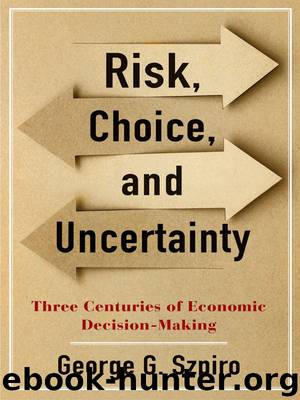Risk, Choice, and Uncertainty by George G. Szpiro

Author:George G. Szpiro
Language: eng
Format: epub
Tags: BUS023000, Business & Economics/Economic History, BUS019000, Business & Economics/Decision-Making & Problem Solving
Publisher: Columbia University Press
Published: 2020-01-07T00:00:00+00:00
FIGURE 7.3: John von Neumann and Oskar Morgenstern (l-r); Dorothy Morgenstern Thomas, photographer.
Source: Shelby White and Leon Levy Archives Center, Institute for Advanced Study, Princeton, New Jersey.
The infamous Anschluss, the takeover of power by the Nazis in Vienna, took place in March. Morgenstern was removed from his post at the university as “politically unbearable,” and his institute was taken over by his former deputy, a Nazi. The dismissals were not racially motivated; rather, they were due to Morgenstern’s liberal attitude, an outlook that was the only thing he had inherited from his alleged grandfather, Frederick III. Morgenstern wisely decided to remain in the United States. He received job offers from various universities but decided to accept a three-year appointment at Princeton, where he hoped finally to meet and work with von Neumann. Half his salary at Princeton was paid by—you guessed it—the Rockefeller Foundation.
Eventually, Morgenstern not only met von Neumann, but became acquainted with some of the world’s foremost economists, mathematicians, and physicists, among them Niels Bohr and Albert Einstein. In particular, Bohr’s preoccupation with the disturbance of an experiment by the observer, one of the fundamental problems in quantum mechanics, brought to mind how Professor Moriarty’s foresight, or lack thereof, could influence the outcome of an event. And Einstein’s dinner proclamations about the priority of theory over experiment also struck a chord. The relationship between Morgenstern and von Neumann required no intermediary because there was an “instantaneous meeting of minds and a spontaneous empathy.”5 Morgenstern managed to rekindle von Neumann’s interest in games, a subject on which the latter had not spent much time since the publication of his original article. The two men exchanged reprints of their papers, and thus began one of the most important and fruitful scientific collaborations of the twentieth century.
Convinced of the tremendous possibilities of game theory, albeit as yet in only a rudimentary form, Morgenstern began to write a paper in which he expounded on its significance to economists. Upon a first reading of the manuscript, von Neumann remarked that it was too concise for readers who were unfamiliar with the subject. It would have to be expanded in order to make the theory accessible to nonmathematicians. Morgenstern went back to work, but when he showed von Neumann the new version, the latter was still not satisfied with it. Then he made a suggestion: “Why don’t we write this paper together?” Morgenstern was overjoyed. He had come to Princeton in the hope of meeting the great mathematician, and now, of all things, they would collaborate! How much better could it get? “Here was Johnny wanting to work with me, both of us pushing into a vast new field, never doubting its challenge, difficulty, and promise.”
The two scholars embarked upon their project in the fall of 1940. Speaking German between themselves but writing in English, all their work was done jointly, the handwriting on the drafts sometimes changing two or three times on the same page. But as they labored on, the paper became longer and longer.
Download
This site does not store any files on its server. We only index and link to content provided by other sites. Please contact the content providers to delete copyright contents if any and email us, we'll remove relevant links or contents immediately.
Hit Refresh by Satya Nadella(9038)
The Compound Effect by Darren Hardy(8808)
Change Your Questions, Change Your Life by Marilee Adams(7635)
Nudge - Improving Decisions about Health, Wealth, and Happiness by Thaler Sunstein(7615)
The Black Swan by Nassim Nicholas Taleb(7010)
Deep Work by Cal Newport(6879)
Daring Greatly by Brene Brown(6444)
Rich Dad Poor Dad by Robert T. Kiyosaki(6401)
Principles: Life and Work by Ray Dalio(6209)
Man-made Catastrophes and Risk Information Concealment by Dmitry Chernov & Didier Sornette(5921)
Playing to Win_ How Strategy Really Works by A.G. Lafley & Roger L. Martin(5917)
Digital Minimalism by Cal Newport;(5664)
Big Magic: Creative Living Beyond Fear by Elizabeth Gilbert(5610)
The Myth of the Strong Leader by Archie Brown(5425)
The Slight Edge by Jeff Olson(5346)
Discipline Equals Freedom by Jocko Willink(5285)
The Motivation Myth by Jeff Haden(5156)
Stone's Rules by Roger Stone(5026)
The Laws of Human Nature by Robert Greene(4997)
